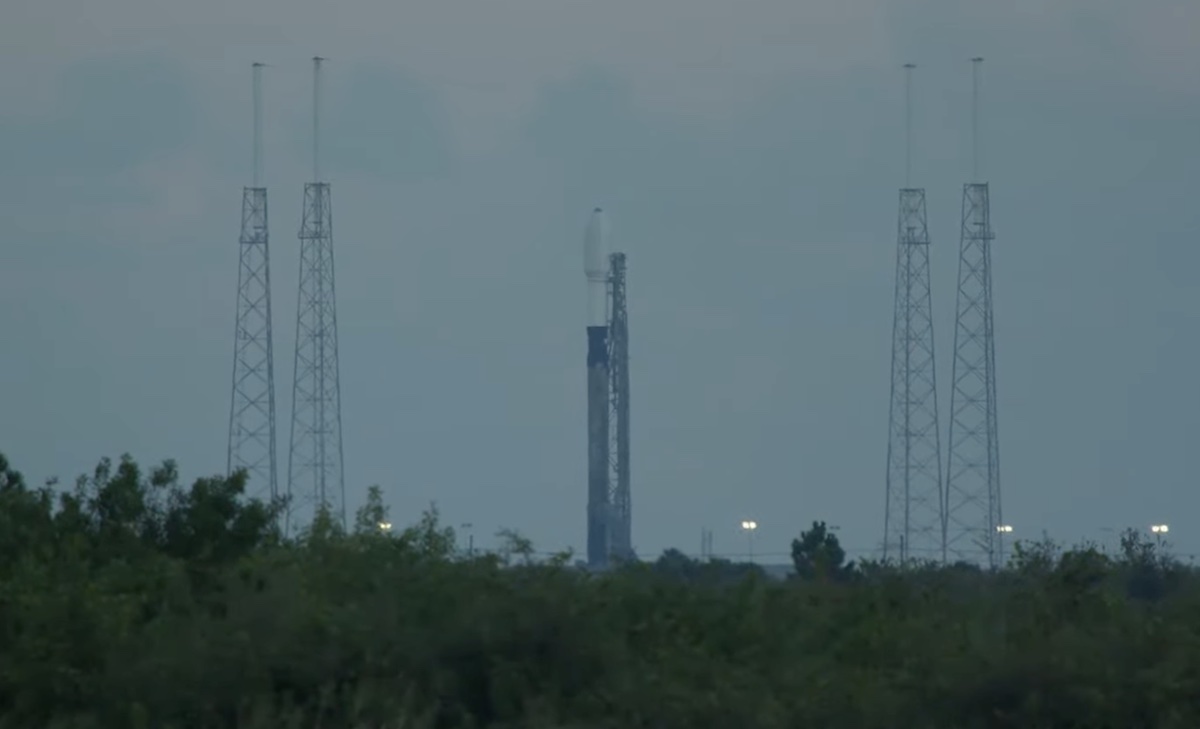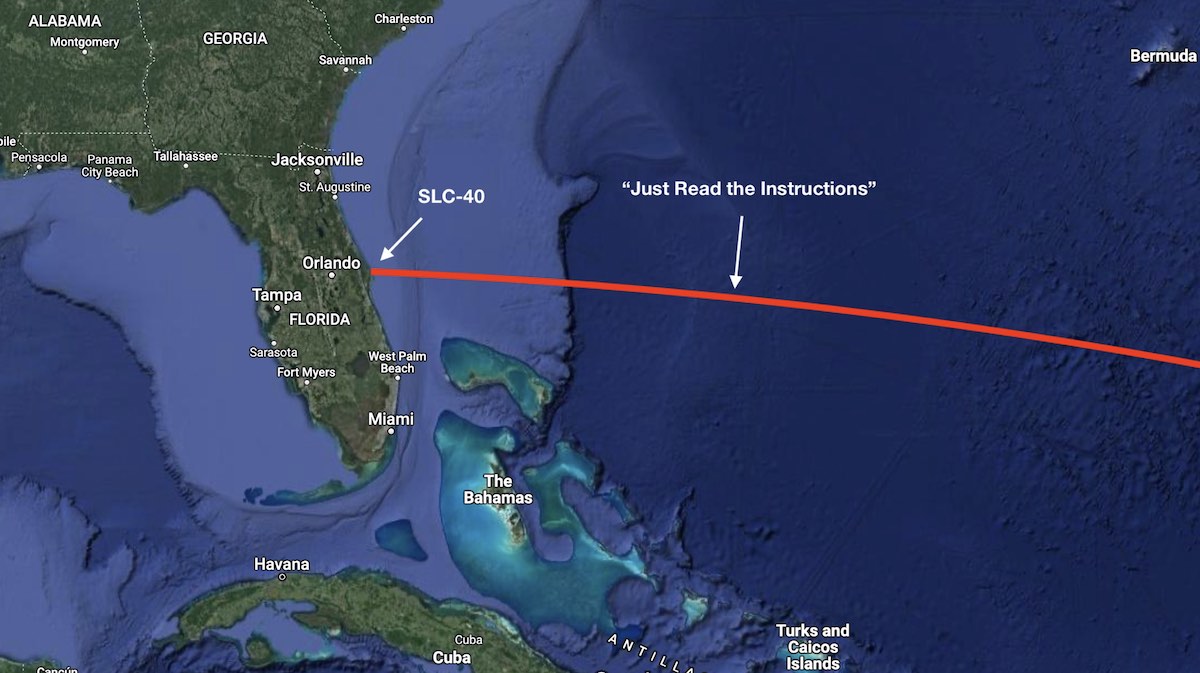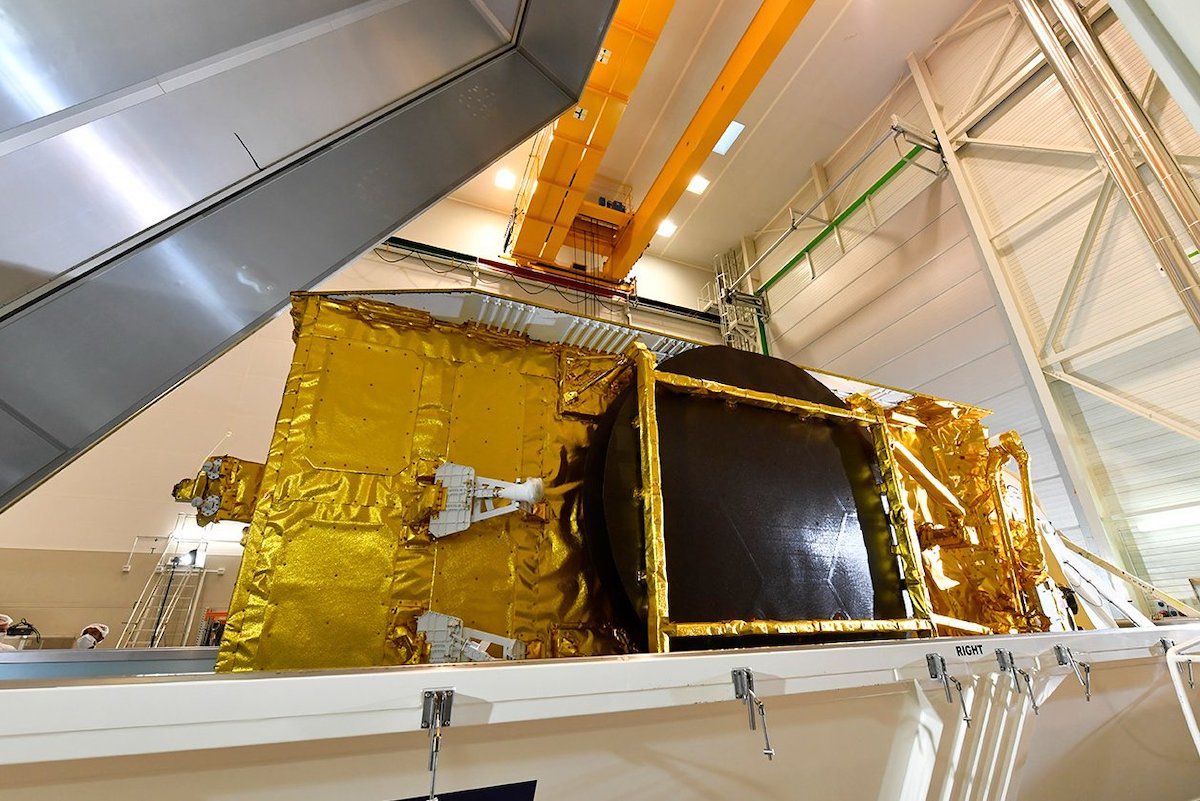Live coverage of the countdown and launch of a SpaceX Falcon 9 rocket from Space Launch Complex 40 at Cape Canaveral Space Force Station, Florida. The Falcon 9 rocket will launch Eutelsat’s Hotbird 13G geostationary communications satellite. Follow us on Twitter.
SFN Live
SpaceX launched a Falcon 9 rocket at 1:22 a.m. EDT (0522 GMT) Thursday from Cape Canaveral with Eutelsat’s Hotbird 13G television broadcasting satellite. The Falcon 9’s first stage booster landed on a downrange drone ship in the Atlantic Ocean.
Ground teams rolled the Falcon 9 to pad 40 at Cape Canaveral Space Force Station on Wednesday, the day after SpaceX launched a powerful Falcon Heavy rocket from pad 39A a few miles up the coast. The 229-foot-tall (70-meter) Falcon 9 was raised vertical on pad 40 Wednesday afternoon ahead of the overnight launch window.
Forecasters from the U.S. Space Force’s 45th Weather Squadron predicted a 90% probability of favorable weather for liftoff, with only a slight chance of cumulus clouds that might create a threat of lightning.
Built by Airbus, the roughly 10,000-pound (4.5-metric ton) Hotbird 13G spacecraft will beam hundreds of television and radio channels across Europe, the Middle East, and North Africa. Hotbird 13G is the twin satellite of Hotbird 13F, which launched Oct. 15 on a previous SpaceX Falcon 9 mission. The two Hotbirds are the first satellites to be built on Airbus’s new Eurostar Neo spacecraft design, incorporating upgrades in propulsion, thermal control, and electrical systems.
During Thursday morning’s countdown, the Falcon 9 launcher was filled with a million pounds of kerosene and liquid oxygen propellants in the final 35 minutes before liftoff.
After teams verified technical and weather parameters were all “green” for launch, the nine Merlin 1D main engines on the first stage booster flashed to life with the help of an ignition fluid called triethylaluminum/triethylborane, or TEA-TEB. Once the engines ramped up to full throttle, hydraulic clamps opened to release the Falcon 9 for its climb into space.
The nine main engines produced 1.7 million pounds of thrust for about two-and-a-half minutes, propelling the Falcon 9 and Eutelsat’s Hotbird 13G communications satellite into the upper atmosphere. Then the booster stage — tail number B1067 in SpaceX’s fleet — shut down and separated from the Falcon 9’s upper stage.

The booster extended titanium grid fins and pulsed cold gas thrusters to orient itself for a tail-first entry back into the atmosphere, before reigniting its engines for a braking burn and a final landing burn, targeting a vertical descent to the drone ship “Just Read the Instructions” parked about 420 miles (about 675 kilometers) east of Cape Canaveral.
The successful rocket landing on the drone ship marked the completion of the booster’s seventh flight to space. The booster debuted June 3, 2021, with the launch of a Dragon cargo mission to the International Space Station, and launched two astronaut crews into space on NASA’s Crew-3 and Crew-4 missions. It has also launched the Turksat 5B communications satellite, another space station resupply mission, and most recently a batch of Starlink internet satellites on Sept. 18.
For the Hotbird 13G mission, the Falcon 9 rocket fired its upper stage engine two times to inject the spacecraft into an elliptical geostationary transfer orbit with an apogee, or high point, more than 30,000 miles (50,000 kilometers) above Earth.
Hotbird 13G separated from the Falcon 9 rocket about 36 minutes into the mission.
After deploying from the Falcon 9 launcher to begin its journey toward geostationary orbit, Hotbird 13G will unfurl solar panels and use PPS5000 plasma orbit-raising thrusters developed by the French company Safran for several months of orbit-raising maneuvers to reach a circular geostationary orbit more than 22,000 miles (nearly 36,000 kilometers) over the equator.
The fuel-efficient plasma propulsion system relies on xenon gas and electricity to generate thrust, rather than a conventional liquid rocket fuel like hydrazine. That reduces the weight of the satellite, allowing engineers to launch on a smaller rocket or add additional payloads to support more communications capacity for customers.
But the orbit-raising using electric propulsion takes longer than maneuvers relying on conventional rocket engines.
Hotbird 13G, like its predecessor Hotbird 13F, will orbit in lock-step with Earth’s rotation at 13 degrees east longitude.

By the middle of next year, Hotbird 13G should be ready to enter commercial service to start a 15-year mission broadcasting television programming to Eutelsat customers. Thanks to improvements in satellite communications technology, Eutelsat will only need two new Hotbird satellites to replace the three aging Hotbird spacecraft operating at 13 degree east.
Pascal Homsy, Eutelsat’s chief technical officer, said the Hotbird fleet at 13 degrees east form the highest capacity satellite broadcasting system covering the Europe, Middle East, and North Africa regions, delivering 1,000 TV channels to more than 160 million homes. Hotbird 13F and 13G will broadcast signals in Ku-band frequencies.
“We have something like over 600 pay TV channels, 300 free to air channels, 450 high definition TV, and 14 ultra high definition channels broadcast from this flagship 13 degrees east position,” Homsy said last month before the launch of Hotbird 13F. “We are able also to provide 500 radio stations and multimedia services.”
The launch of Hotbird 13G was SpaceX’s 51st mission of 2022, and the second in a series of three Falcon 9 flights this year for Eutelsat. The Eutelsat 10B communications satellite, designed to provide in-flight internet connectivity to airline passengers, was delivered from Europe to Cape Canaveral by boat last week for a launch on a Falcon 9 rocket later this month.

ROCKET: Falcon 9 (B1067.7)
PAYLOAD: Hotbird 13G communications satellite
LAUNCH SITE: SLC-40, Cape Canaveral Space Force Station, Florida
LAUNCH DATE: Nov. 2/3, 2022
LAUNCH WINDOW: 11:26 p.m. – 1:22 a.m. EDT (0326-0522 GMT)
WEATHER FORECAST: 90% probability of acceptable weather
BOOSTER RECOVERY: “Just Read the Instructions” drone ship
LAUNCH AZIMUTH: East
TARGET ORBIT: Geostationary transfer orbit
LAUNCH TIMELINE:
- T+00:00: Liftoff
- T+01:12: Maximum aerodynamic pressure (Max-Q)
- T+02:32: First stage main engine cutoff (MECO)
- T+02:35: Stage separation
- T+02:43: Second stage engine ignition
- T+03:23: Fairing jettison
- T+06:30: First stage entry burn ignition (three engines)
- T+06:55: First stage entry burn ends
- T+08:08: Second stage engine cutoff (SECO 1)
- T+08:22: First stage landing burn ignition (one engine)
- T+08:44: First stage landing
- T+29:11: Second stage engine restart
- T+30:10: Second stage engine cutoff (SECO 2)
- T+36:11: Hotbird 13G separation
MISSION STATS:
- 184th launch of a Falcon 9 rocket since 2010
- 193rd launch of Falcon rocket family since 2006
- 7th launch of Falcon 9 booster B1067
- 157th Falcon 9 launch from Florida’s Space Coast
- 102nd Falcon 9 launch from pad 40
- 157th launch overall from pad 40
- 125th flight of a reused Falcon 9 booster
- 4th SpaceX launch for Eutelsat
- 50th Falcon 9 launch of 2022
- 51st launch by SpaceX in 2022
- 48th orbital launch attempt based out of Cape Canaveral in 2022
Email the author.
Follow Stephen Clark on Twitter: @StephenClark1.
